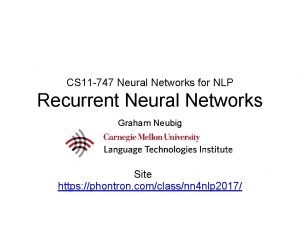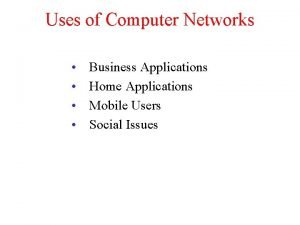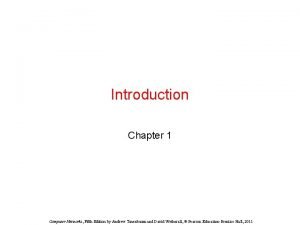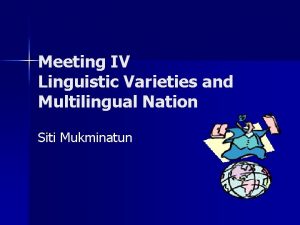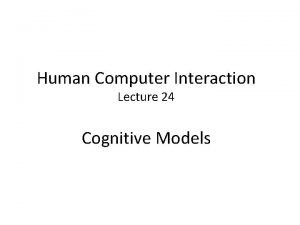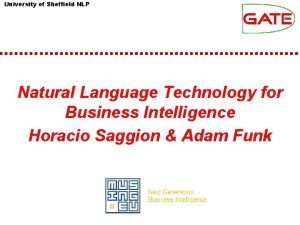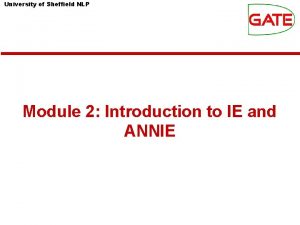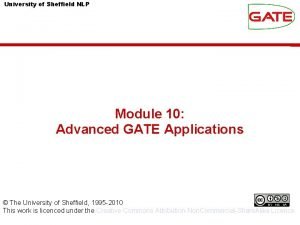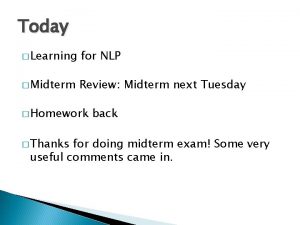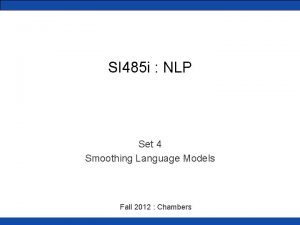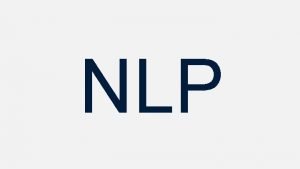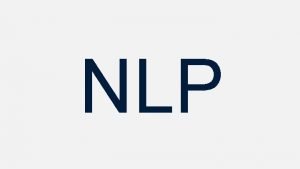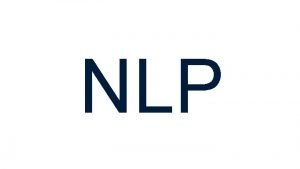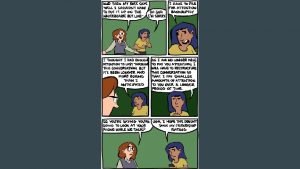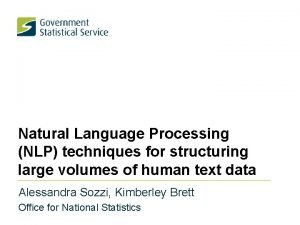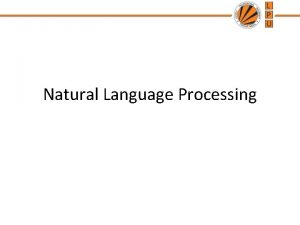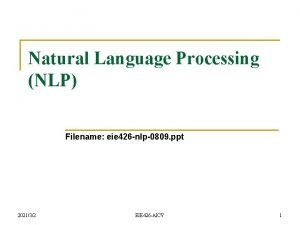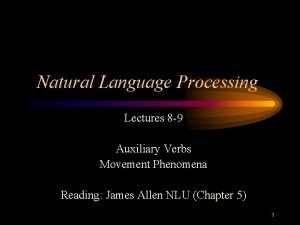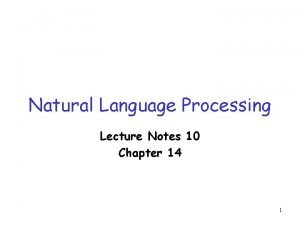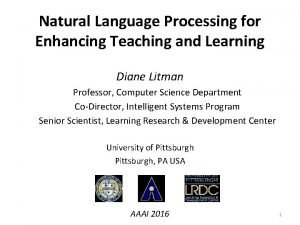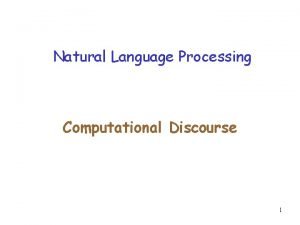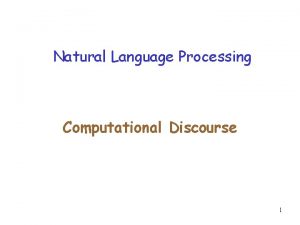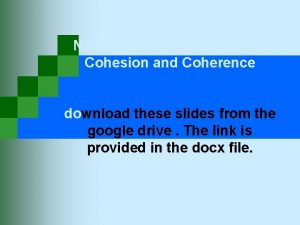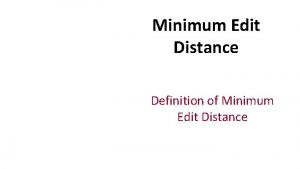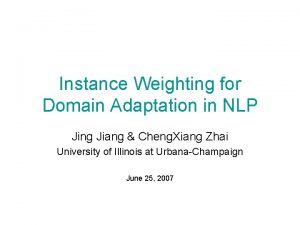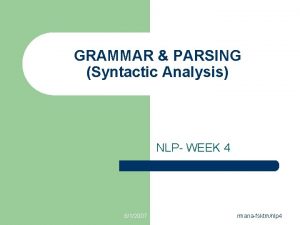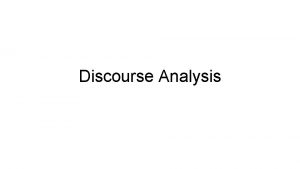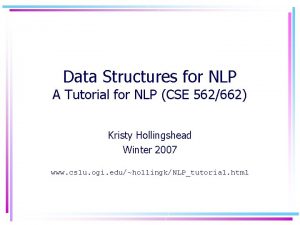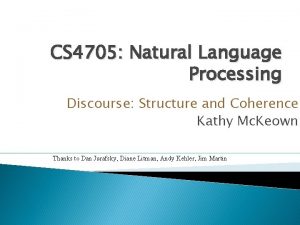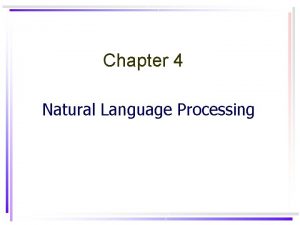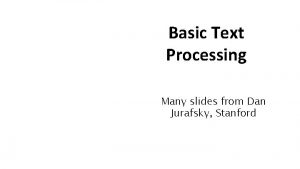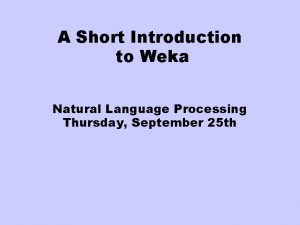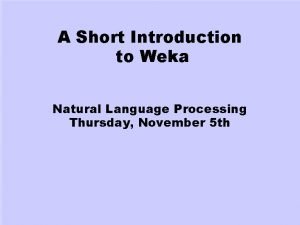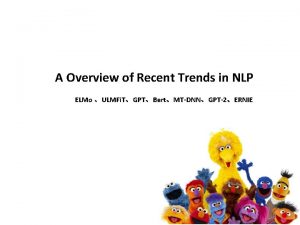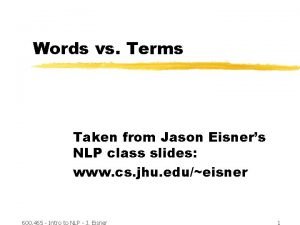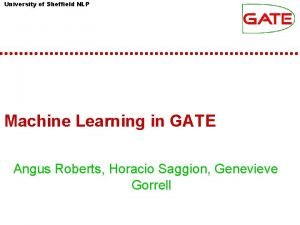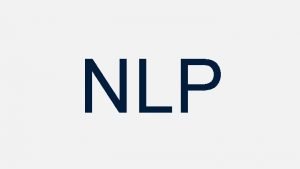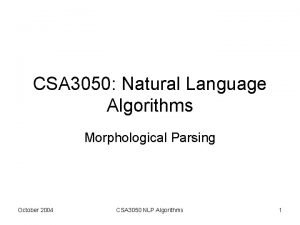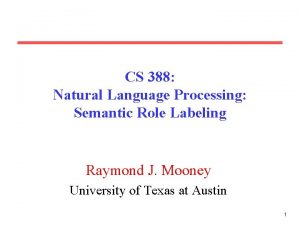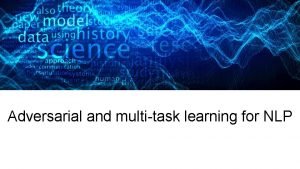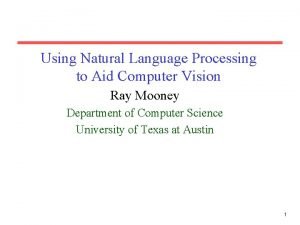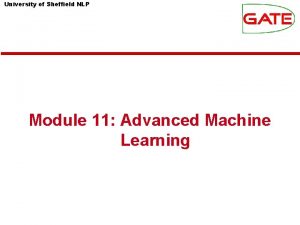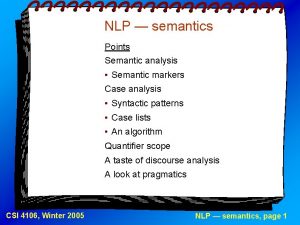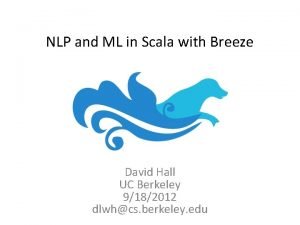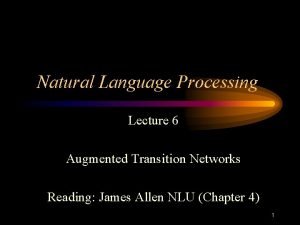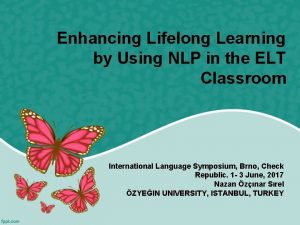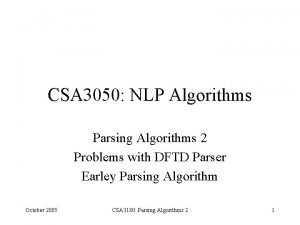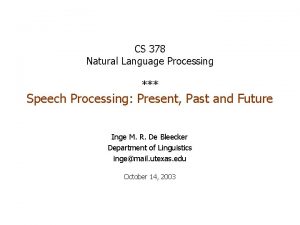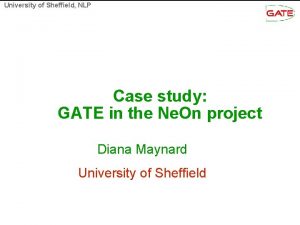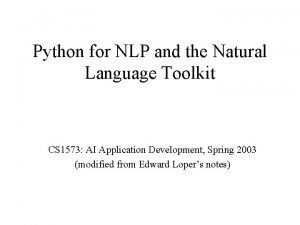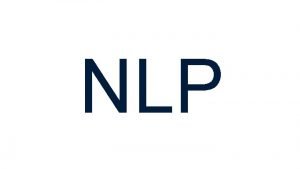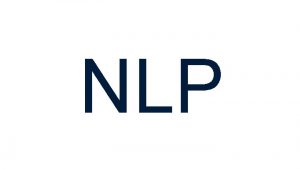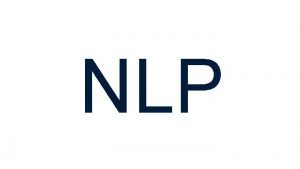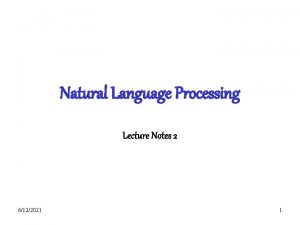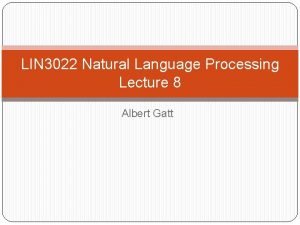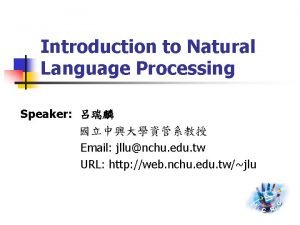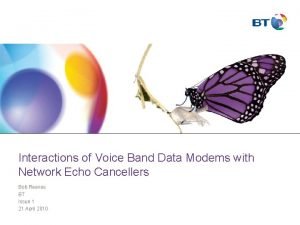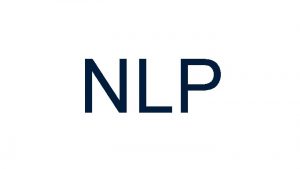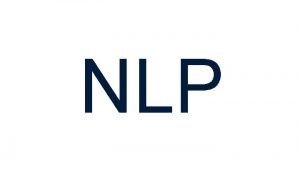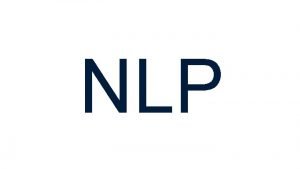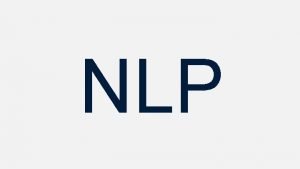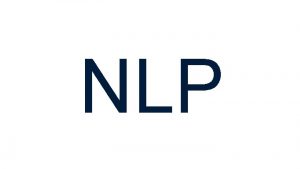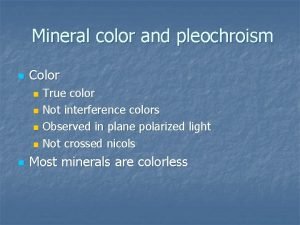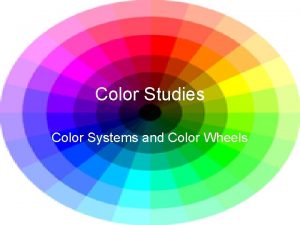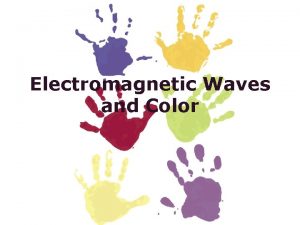Linguistic Networks Applications in NLP and CL color













































































- Slides: 77

Linguistic Networks Applications in NLP and CL color sky weight light Microsoft Research India 1 blood monojitc@microsoft. com 20 blue 100 heavy red Monojit Choudhury

NLP vs. Computational Linguistics • Computational Linguistics is the study of language using computers and language-using computers • NLP is an engineering discipline that seeks to improve human-human, human-machine and machine-machine(? ) communication by developing appropriate systems.

Charting the World of NLP Unsupervised learning Supervised learning Graph Theory ion lat ra ns ac hin e. T Pa rsi Sp ng ell -ch ec kin g M An ap ho ra r es olu tio n Data mining

Outline of the Talk • A broader picture of research in the merging grounds of language and computation • Complex Network Theory • Application of CNT in linguistics and NLP • Two case studies

LINGUISTIC system Representation and Processing zul u sem anti Change & Evolution net wo rk syn tax D D @ Learning P A lexi ca NL P wo rd ba ngl a com plex mo del evolu tion P O S no de ed ge r lea g nin Perception I speak, therefore I am. Production 5

LINGUISTIC system Representation and Processing Psycholinguistics Neurolinguistics Change & Evolution Socio/Dia. Linguistics Games/Simulations zul u sem anti D D @ Learning P A lexi ca NL P wo rd ba ngl a com plex net wo rk syn tax mo del evolu tion P O S no de ed ge r lea g nin Perception I speak, therefore I am. Theo. Linguistics Data Modeling Production 6

Language is a Complex Adaptive System • Complex: – Parts cannot explain the whole (reductionism fails) – Emerges from the interactions of a huge number of interacting entities • Adaptive – It is dynamic in nature (evolves) – The evolution is in response to the environmental changes (paralinguistic and extra-linguistic factors)

Layers of Complexity • Linguistic Organization: – phonology, morphology, syntax, semantics, … • Biological Organization: – Neurons, areas, faculty of language, brain, • Social Organization: – Individual, family, community, region, world • Temporal Organization: – Acquisition, change, evolution

Layers of Complexity • Linguistic Organization: Linguists – phonology, morphology, syntax, semantics, … Physicist • Biological Organization: – Neurons, areas, faculty of language, brain, • Social Organization: Social scientist Neuroscientist – Individual, family, community, region, world • Temporal Organization: Computer – Acquisition, change, evolution Scientists Psychologist

Complex System View of Language • Emerges through interactions of entities • Microscopic view: individual’s utterances • Mesoscopic view: linguistic entities (words, phones) • Macroscopic view: language as a whole (grammar and vocabulary)

Complex Network Models • Nodes: Social entities (people, organization etc. ) • Edges: Interaction/relationship between entities (Friendship, collaboration) Courtesy: http: //blogs. clickz. com 11

Linguistic Networks color sky weight light 1 20 blue blood 100 heavy red 12

Complex Network Theory • Handy toolbox for modeling complex systems • Marriage of Graph theory and Statistics • Complex because: – Non-trivial topology – Difficult to specify completely – Usually large (in terms of nodes and edges) • Provides insight into the nature and evolution of the system being modeled 13

Internet 14

9 -11 Terrorist Network Social Network Analysis is a mathematical methodology for connecting the dots -- using science to fight terrorism. Connecting multiple pairs of dots soon reveals an emergent network of organization. 15

What Questions can be asked • Do these networks display some symmetry? • Are these networks creation of intelligent objects (by design) or have emerged (self-organized)? • How have these networks emerged: What are the underlying simple rules leading to their complex structure? 16

Bi-directional Approach • Analysis of the real-world networks – Global topological properties – Community structure – Node-level properties • Synthesis of the network by means of some simple rules – Small-world models ……. . – Preferential attachment models 17

Application of CNT in Linguistics - I • Quantitative & Corpus linguistics – Invariance and typology – Properties of NL Corpora • Natural Language Processing – Unsupervised methods for text labeling (POS tagging, NER, WSD, etc. ) – Textual similarity (automatic evaluation, document clustering) – Evolutionary Models (NER, multi-document summarization) 18

Application of CNT in Linguistics - II • Language Evolution – How did sound systems evolve? – Development of syntax • Language Change – Innovation diffusion over social networks – Language as an evolving network • Language Acquisition – Phonological acquisition – Evolution of the mental lexicon of the child 19

Linguistic Networks Name Nodes Edges Why? Pho. Net Phoneme Co-occurrence likelihood in languages Evolution of sound systems Word. Net Words Ontological relation Host of NLP applications Syntactic Network Words Similarity between syntactic contexts POS Tagging Semantic Network Words, Names Semantic relation IR, Parsing, NER, WSD Mental Lexicon Words Phonetic similarity and semantic relation Cognitive modeling, Spell Checking Tree-banks Words Syntactic Dependency links Evolution of syntax Word Cooccurrence Words Co-occurrence IR, WSD, LSA, … 20

Case Study I Word co-occurrence Networks 21

Word Co-occurrence Network disti nct neig hbori ng inte ract ing stru ctur e Words are nodes. Two words are connected by an edge if they are adjacent in a sentence (directed, weighted) we b word evol ving sent enc es suc h com plex a trea t in ca n lang uage hum an Proc of the Royal Society of London B, 268, 2603 -2606, 2001 is as netw ork 22

Topological characteristics of WCN R. Ferrer-i-Cancho and R. V. Sole. The small world of human language. Proceedings of The Royal Society of London. Series B, Biological Sciences, 268(1482): 2261 -2265, 2001 R. Ferrer-i-Cancho and R. V. Sole. Two regimes in the frequency of words and the origin of complex lexicons: Zipf's law revisited. Journal of Quantitative Linguistics, 8: 165 - 173, 2001 WCN for human languages are small world accessing mental lexicon is fast. The degree distribution of WCN follows two-regime power law core and peripheral lexicon 23

Degree Distribution (DD) • Let pk be the fraction of vertices in the network that has a degree k. • The k versus pk plot is defined as the degree distribution of a network • For most of the real world networks these distributions are right skewed with a long right tail showing up values far above the mean – pk varies as k-α – Cumulative degree distribution is plotted

Compute the degree distribution of the following network disti nct neig hbori ng inte ract ing stru ctur e we b word evol ving sent enc es suc h com plex a trea t in ca n lang uage hum an is as

A Few Examples Power law: Pk ~ k-α

WCN has two regime power-law Low degree words form the peripheral lexicon High degree words form the core lexicon 27

Core-periphery Structure • Core: A densely connected set of fewer nodes • Periphery: A large number of nodes sparsely connected to core-nodes • Fractal Networks: Recursive core-periphery structure ML has a core-periphery structure (perhaps recursive) Core lexicon = function words plus generic concepts Peripheral lexicon = jargons, specialized vocabulary 28

Topological characteristics of WCN R. Ferrer-i-Cancho and R. V. Sole. The small world of human language. Proceedings of The Royal Society of London. Series B, Biological Sciences, 268(1482): 2261 -2265, 2001 R. Ferrer-i-Cancho and R. V. Sole. Two regimes in the frequency of words and the origin of complex lexicons: Zipf's law revisited. Journal of Quantitative Linguistics, 8: 165 - 173, 2001 The degree distribution of WCN follows two-regime power law core and peripheral lexicon WCN for human languages are small world accessing mental lexicon is fast. 29

Small World Phenomenon • A Network is small world iff it has – Scale-free (power law) degree distribution – High clustering coefficient – Small diameter (average path length)

Measuring Transitivity: Clustering Coefficient • The clustering coefficient for a vertex ‘v’ in a network is defined as the ratio between the total number of connections among the neighbors of ‘v’ to the total number of possible connections between the neighbors • High clustering coefficient means my friends know each other with high probability – a typical property of social networks

Mathematically… • The clustering coefficient of a vertex i is # of links between ‘n’ neighbors Ci = n(n-1)/2 • The clustering coefficient of the whole network is the average C= 1 N ∑Ci • Alternatively, C= # triangles in the n/w # triples in the n/w

Diameter of a Network disti nct neig hbori ng inte ract ing stru ctur e we b word evol ving sent enc es suc h com plex a netw ork trea t in ca n lang uage hum an is as • Diameter of a network is the length of the longest smallest path among all pairs of vertices. • A network with N nodes is said to be small world if the diameter scales as log(N) • 6 degrees of separation! 33

Which of these are Small World N/ws? hum an u str ur ct e we b word we stru ctur e rd o w sent enc es lang uage in c h com plex a a netw ork trea t in suc h is su we b sent enc es trea t in suc h m co lex p Path (or line graph) ca n neig hbori ng b Tree as hum an Star ca n lang uage is as 34

WCN are small worlds! • Activation of any word will need only a very few steps to activate any other word in the network • Thus, spreading of activation is really fast • Lesson: ML has a topological structure that supports very fast spreading of activation and thus, very fast lexical access. 35

Self-organization of WCN Dorogovtsev-Mendes Model disti nct neig hbori ng inte ract ing * A new node joins the network at every time step t. * It attaches to an existing node with probability proportional to degree * ct new edges are added proportional to degrees of existing nodes stru ctur e we b word evol ving sent enc es suc h com plex a trea t in ca n lang uage hum an Proc of the Royal Society of London B, 268, 2603 -2606, 2001 is as netw ork 36

DM Model leads to two regime power-law networks kcut ∼ √(t/8)(ct)3/2 kcross ≈ √(ct)(2+ct)3/2 37

Significance of The DM Model • Topological significance – Apart from degree distribution, what other properties of WCN can and cannot be explained by the DM model • Linguistic and Cognitive Significance – What linguistic/cognitive phenomenon is being modeled here? – What is the significance of the parameter c. 38

Structural Equivalence (Similarity) • Two nodes are said to be exactly structurally equivalent if they have the same relationships to all other nodes. Computation: Let A be the adjacency matrix. Compute the Euclidean Distance /Pearson Correlation between a pair or rows/columns representing the neighbor profile of two nodes (say i and j). This value shows how much structurally similar i and j are.

Probing Deeper than Degree Distribution • Co-occurrence of words are governed by their syntactic and semantic properties • Therefore, words occurring in similar context has similar properties (distribution) • Structural Equivalence: How similar are the local neighborhood of the two nodes? • Social Roles – Nodes (actors) in a social n/w who have similar patterns of relations (ties) with other nodes 40

Structural Similarity Transform Degree distribution of real and DM networks after taking structural similarity transforms Lesson: DM Model cannot take into account the distributional properties of words and hence it is topologically different from WCNs 41

Spectral Analysis Reflects the global topology of the network through the distributions of eigenvalues and eigenvectors of the Adjacency matrix Spectral Analysis shows that real networks are much more structured than those generated by DM Model 42

Global Topology of WCN: Beyond the two-regime power law Choudhury et al. , Coling 2010 43

Significance of Parameter c in DM Model • t (also, #nodes) is actually the rate of seeing a new unigram (which varies with corpus size N) • #Edges is the number of unique bigrams • c is a function of N !! 44

Things you know • Topological properties: – Degree distribution, Small world, Path lengths, Structural equivalence, core-periphery structure, fractal networks, spectrum of a network • Types of networks – Power-law, two-regime power-law, core-periphery, trees or hierarchical, small world, cliques, paths • Network Growth Models – Preferential attachment, DM model 45

Things to explore yourself • More node properties: – Clustering coefficient: friends of friends are friends – Centrality: Degree, betweenness, eigenvector centrality • Types of Networks – Assortative, super-peer neig hbori ng inte ract ing we b word • Community Analysis – Definitions and Algorithms • Random networks stru ctur e evol ving sent enc es suc h com plex a trea t in ca n lang uage hum an is as 46

Phonological Neighborhood Networks nt e m rds o w eg s 2 -4 0 s 1 8 eg nt e m rds o w Removal of lowdegree nodes disconnect the n/w as opposed to the removal of hubs like “pastor” (deg. =112)

CASE STUDY II: Unsupervised POS Tagging 48

Labeling of Text • • • Lexical Category (POS tags) Syntactic Category (Phrases, chunks) Semantic Role (Agent, theme, …) Sense Domain dependent labeling (genes, proteins, …) How to define the set of labels? How to (learn to) predict them automatically? 49

What are Parts-of-Speech (POS)? Distributional Hypothesis: “A word is characterized by the company it keeps” – Firth, 1957 The X is a … You Y that, did not you? Part-Of-Speech (POS) induction – Discovering natural morpho-syntactic classes – Words that belong to these classes 50

1: Acquire raw text corpus In the context of network theory, a complex network is a network (graph) with non-trivial topological features— features that do not occur in simple networks such as lattices or random graphs. The study of complex networks is a young and active area of scientific research inspired largely by the empirical study of real-world networks such as computer networks and social networks. Most social, biological, and technological networks display substantial non-trivial topological features, with patterns of connection between their elements that are neither purely regular nor purely random. http: //www. wikipedia. org/ ব ল স হ তয র মধযযগ ব শ ষ এক শর ণ র ধরমব ষযক আখয ন ক বয মঙগলক বয ন ম পর চ ত। বল হয থ ক , য ক বয দ বত র আর ধন , ম হ তয -ক রতন কর হয , য ক বয শরবণ ও মঙগল হয এব ব পর ত হয অমঙগল ; য ক বয মঙগল ধ র , এমন ক , য ক বয য র ঘর র খল ও মঙগল হয ত ক বল হয মঙগলক বয। মঙগলক বয ব শ ষ হ নদ দ বত য র “ন মনক ট ” ন ম

1: Acquire raw text corpus In the context of network theory, a complex network is a network (graph) with non-trivial topological features— features that do not occur in simple networks such as lattices or random graphs. The study of complex networks is a young and active area of scientific research inspired largely by the empirical study of real-world networks such as computer networks and social networks. Most social, biological, and technological networks display substantial non-trivial topological features, with patterns of connection between their elements that are neither purely regular nor purely random. http: //en. wikipedia. org/wiki/Complex_network Feature word

1: Acquire raw text corpus In the context of network theory, a complex network is a network (graph) with non-trivial topological features— features that do not occur in simple networks such as lattices or random graphs. The study of complex networks is a young and active area of scientific research inspired largely by the empirical study of real-world networks such as computer networks and social networks. Most social, biological, and technological networks display substantial non-trivial topological features, with patterns of connection between their elements that are neither purely regular nor purely random. http: //en. wikipedia. org/wiki/Complex_network Target word Feature word

2: Construct context vectors In the context of network theory, a complex network is a network (graph) with non-trivial topological features—features that do not occur in simple networks such as lattices or random graphs. The study of complex networks is a young and active area of scientific research inspired largely by the empirical study of real-world networks such as computer networks and social networks. Most social, biological, and technological networks display substantial non-trivial topological features, with patterns of connection between their elements that are neither purely regular nor purely random. networks of a and is as PU … the -2 2 0 1 0 … 0 -1 0 0 0 … 0 1 0 0 1 1 0 1 … 0 2 0 1 0 0 2 0 … 0

3: Construct network Words are nodes. The weight of the edge between nodes (words) u and v is: sim(u, v) = cos(u, v ) occ ur patt ern substa ntial netw ork most regu lar elem ents inspir ed gra phs netw orks young com plex social simp le rand om active pur ely comp uter gra ph latti ces ar ea feat ures stu dy displ ay

Experiments • Cluster the Network – Hierarchical clustering – Random walk based clustering • Study the topological properties of the networks across languages • Develop unsupervised POS tagger

Languages • • Bangla (2 M, ABP) Catalan (3 M, LCC) Czech (4 M, LCC) Danish (3 M, LCC) Dutch (18 M, LCC) English (6 M, BNC) Finnish (11 M, LCC) French (3 M, LCC) • • German (40 M, Wortschatz) Hindi (2 M, DJ) Hungarian (18 M, LCC) Icelandic (14 M , LCC) Italian (9 M, LCC) Norwegian (16 M, LCC) Spanish (4. 5 M, LCC) Swedish (3 M, LCC) http: //wortschatz. uni-leipzig. de/~cbiemann/software/unsupos. html 57

Structural Properties: Degree Distribution Power-law with exponent -1 (Zipf Distribution) Pk k Inference: Hierarchical organization of the morpho-syntactic ambiguity classes. 58

Structural Properties: Clustering Coefficient • Community structure; CC • Frequent words connect to frequent words (rich club phenomenon), k Avg. CC = 0. 53 High k High CC (Pearson = 0. 49) • Existence of a large core 59

Clustering Algorithms • Crisp/hard vs. Fuzzy/soft • Hierarchical vs. non-hierarchical • Divisive vs. Agglomerative • Popular strategies – k-means – Hierarchical agglomerative clustering – Spectral clustering (Shi-Malik algorithm)

Syntactic Network of Words color sky weight light 1 20 blue 100 blood heavy 1 1 – cos(red, blue) red 61

The Chinese Whispers Algorithm color sky weight 0. 9 0. 8 light -0. 5 0. 7 blue blood 0. 9 0. 5 heavy red 62

The Chinese Whispers Algorithm color sky weight 0. 9 0. 8 light -0. 5 0. 7 blue blood 0. 9 0. 5 heavy red 63

The Chinese Whispers Algorithm color sky weight 0. 9 0. 8 light -0. 5 0. 7 blue blood 0. 9 0. 5 heavy red 64

Structural Properties: Cluster Size Distribution 10000 1000 size Power-law with exponent close to -1 100 10 1 1 10 1000 rank Inference: Fractal nature of the Network MSR-I TAB Presentation 2008 65

The Clusters Bangla গ লম ল র , দ ব র , আগন র , ফল র , মন ভ ব র , দষণ র , বযয় র , ম থ র , কথ র , ব ধ র … (352) Genitive Nouns (189) Adverbs defiantly, steadily, uncertainly, abruptly, thoughtfully, neatly, uniformly, freely, upwards, aloud, sidelong, savagely … English Finnish kaksi, kaksi-kolme, viiteen, vajaata, 22: een, miljoona, 40 -vuotiaan … Quantifiers (199) Adjectives (590) chinesischer, Deutscher, nationalistischer, grüner, tamilischer, indianischer, amerikanischer … German 66

Proper Nouns Bangla Finnish Blair, Singh, Azad, Chowdhury, Kumar, Ganguly, Khan, Gandhi, Das, Basu, Roy, Sen, Bush, … (102) Surnames (988) Places Punjab, Spain, Vienna, Chicago, Antarctica, Gibraltar, Carnegie, Zambia, North-East, England, Bangladesh, India, USA, Yorks … English Eemil, J-P, Benedictus, Jarl, James, Kristian, Petra, El, Dave, Otto, Bo, Mirka … First Names (919) Acronyms (2884) WIZO, IPOs, FDD, KDA, CIC, IMB, VDP, FIBT, DBAG, G 7, DOG, WJC, Eucom, WWF, Bf. V, L-Bank, Mu. Z, ORH … German 67

Clusters in Bangla Cluster 1: Proper Nouns buddhab. Abu, saurabha, r. Akesha Cluster 2: Noun-genitive golam. Alera (of problem), d. Abira (of right), phalera (of result) Cluster 3: Quantifiers s. Ata. Ti (seven), anekaguli (many), 3 Ti (three) Cluster 4: Noun-locative adhibeshane (during the session), dalei (in party), baktrit. AYe (in speech), bh. ASha. Ne (in speech) Cluster 5: Infinitives bh. Abte (to think), khete (to eat), jitate (to win)

Dendogram of POS in Bangla

Lexicon Induction and Labeling • Fuzzy clusters define lexical categories • Induction of lexicon • Use lexicon to train HMM in an unsupervised manner • Evaluation: Tag perplexity • Result: Improves accuracy of NER, Chunking etc. over no POS tagging, but supervised POS tagging still better 70

Word Sense Disambiguation • Véronis, J. 2004. Hyper. Lex: lexical cartography for information retrieval. Computer Speech & Language 18(3): 223 -252. • Let the word to be disambiguated be “light” • Select a subcorpus of paragraphs which have at least one occurrence of “light” • Construct the word co-occurrence graph 71

Hyper. Lex A beam of white light is dispersed into its component colors by its passage through a prism. Energy efficient light fixtures including solar lights, night lights, energy star lighting, ceiling lighting, wall lighting, lamps What enables us to see the light and experience such wonderful shades of colors during the course of our everyday lives? beam prism dispersed white colors shades energy efficient fixtures lamps 72

Hub Detection and MST light beam prism dispersed white colors beam lamps prism shades white dispersed energy colors fixtures shades energy efficient White fluorescent lights consume less energy than incandescent lamps fixtures lamps 73

Other Related Works • Solan, Z. , Horn, D. , Ruppin, E. and Edelman, S. 2005. Unsupervised learning of natural languages. PNAS, 102 (33): 11629 -11634 • Ferrer i Cancho, R. 2007. Why do syntactic links not cross? Europhysics Letters • Also applied to: IR, Summarization, sentiment detection and categorization, script evaluation, author detection, … 74

One slide summary • Computer science has a much bigger role to play in understanding language than the scope of NLP today • A holistic research agenda in computational linguistics is the need of the hour • Research in linguistic networks is an emerging area with tremendous potentials • Graphs are amazing tools for visualization – and therefore teaching

Resources • Conferences – Text. Graphs, Sunbelt, Evo. Lang, ECCS • Journals – PRE, Physica A, IJMPC, EPL, PRL, PNAS, QL, ACS, Complexity, Social Networks, Interaction Studies • Tools – Pajek, C#UNG, http: //www. insna. org/INSNA/soft_inf. html • Online Resources – Bibliographies, courses on CNT 76

Thank you monojitc@microsoft. com
 11-747 neural networks for nlp
11-747 neural networks for nlp Virtual and datagram networks
Virtual and datagram networks Computer networks and internets with internet applications
Computer networks and internets with internet applications Backbone networks in computer networks
Backbone networks in computer networks Uses of computer networks in business applications
Uses of computer networks in business applications Principles of network applications
Principles of network applications Business applications of computer networks
Business applications of computer networks Business application in computer network
Business application in computer network Odyssey word count
Odyssey word count Social deixis examples
Social deixis examples Structural linguistics and behavioral psychology
Structural linguistics and behavioral psychology Linguistic varieties and multilingual nations
Linguistic varieties and multilingual nations Linguistic model in hci
Linguistic model in hci Sheffield nlp
Sheffield nlp Annie nlp
Annie nlp Gate nlp
Gate nlp Nlp midterm exam
Nlp midterm exam Statistical natural language processing
Statistical natural language processing Smoothing nlp
Smoothing nlp Nlp syntax
Nlp syntax Dot search
Dot search Parsing methods
Parsing methods Ilya sutskever
Ilya sutskever What is nlp techniques
What is nlp techniques Discourse integration in nlp
Discourse integration in nlp Discourse integration in nlp
Discourse integration in nlp Auxiliary verb in nlp
Auxiliary verb in nlp Fopc in nlp
Fopc in nlp Natural language processing
Natural language processing Markov chain nlp
Markov chain nlp Research lifecycle
Research lifecycle Reference phenomenon in nlp
Reference phenomenon in nlp Reference phenomena in nlp
Reference phenomena in nlp Cohesion in nlp
Cohesion in nlp Weighted minimum edit distance
Weighted minimum edit distance Instance weighting for domain adaptation in nlp
Instance weighting for domain adaptation in nlp Nlp syntactic analysis
Nlp syntactic analysis Discourse analysis in nlp
Discourse analysis in nlp Node nlp tutorial
Node nlp tutorial Jurafsky nlp
Jurafsky nlp Discourse segmentation in nlp
Discourse segmentation in nlp Discourse integration in nlp
Discourse integration in nlp Dan jurafsky nlp slides
Dan jurafsky nlp slides Weka nlp
Weka nlp Weka nlp
Weka nlp Elmo nlp
Elmo nlp Information retrieval nlp
Information retrieval nlp Sheffield nlp
Sheffield nlp Context reframe
Context reframe Nlp master
Nlp master Collocations nlp
Collocations nlp Nlp training thailand
Nlp training thailand Natural language processing lecture notes
Natural language processing lecture notes What is morphology in nlp
What is morphology in nlp Morphological parsing in nlp
Morphological parsing in nlp Semantic role labeling nlp
Semantic role labeling nlp Adversarial multi-task learning for text classification
Adversarial multi-task learning for text classification Nlp sekte
Nlp sekte Computer vision vs nlp
Computer vision vs nlp Sheffield nlp
Sheffield nlp Semantic marker
Semantic marker Scala breeze
Scala breeze Augmented transition network in nlp
Augmented transition network in nlp Four pillars of nlp
Four pillars of nlp Parsing algorithms in nlp
Parsing algorithms in nlp Cs378 nlp
Cs378 nlp Extract noun
Extract noun Gate nlp
Gate nlp Nltk frequency distribution
Nltk frequency distribution Nlp
Nlp Language synonyms
Language synonyms Nlp dimensionality reduction
Nlp dimensionality reduction Ipa graph
Ipa graph Nlp lecture notes
Nlp lecture notes Natural language processing lecture notes
Natural language processing lecture notes Bottom all those flight
Bottom all those flight Language
Language Nlp login
Nlp login
